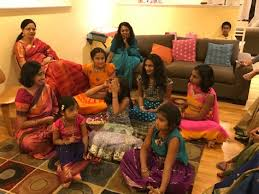Navratri progressing finely and on the four day
of the festival we turn towards music and focus on the role of it in the ongoing
festival.
We all very well know that Devotional songs and
bhajans are sung in praise of Goddess Durga and soulful music help to
connect with the divine energy of the Goddess and invoke her blessings.
When defined as nouns, Kirtan refers to a
song praising a deity while bhajan is a personal communication with the divine.
Kirtan in verb form in northern India refers to group singing of songs which
may include bhajans. In southern India, the word for such a kirtan performance
is referred to as bhajan.
The Bhajans in many Hindu traditions are a form
of congregational singing and bonding, that gives the individual an opportunity
to share in the music-driven spiritual and liturgical experience as well as the
community a shared sense of identity, wherein people share food, meet and
reconnect.
In general Devotional singing, known as bhajans
or kirtan, can help to quiet the mind so that the heart can open to the
divine, allowing us to taste the blissful reality that is our true nature. It
is a participatory spiritual practice in which everyone is encouraged to sing
and express their inner joy. No doubt Navratri is a great occasion for this.
Navaratri Golu is believed to have been
celebrated since the existence of the Vijayanagar kingdom in 14th-century India,
and was especially popular with the royal families of Thanjavur and Pudukkottai
in the state of Tamil Nadu.
Golu consists of a makeshift staircase on which
the dolls, which have been passed on from many generations are kept. Durga
triumphed over Mahishasura on the 10th day of the war, which is
celebrated as Dashara. To pay respect to the self-sacrifice of those deities the
doll festival is observed by worshipping the Gods and Goddesses in the form of
dolls.
It is celebrated in different parts of India
like Andhra Pradesh, Tamil Nadu, and Karnataka by creating dolls as gods,
goddesses, animals, children, and men, etc. The devotees in Tamil Nadu
believe that Bommai Golu or Kolu depicts the presence of God.
After setting up the Golu, friends, relatives and
neighbours are invited to witness and the guest’s usually offer their prayers
by singing devotional songs.
Married women and children,
especially little girls, are specially called in homes each evening to see the
golu. They are requested to also sing devotional songs in the honour of the
goddess. They plan a set of songs, & practice before hand to
sing in at invited golus’
They are then honoured by gifting betel
leaves, coconuts, fruits, flowers, bangles, turmeric, kumkum, and prasad.
The famous songs regularly sung in Golu’s in South India are:
1. Himagiri
Thanaye Hemalathe….
2. Bhaagyada Lakshmi
baaramma….
3. Sri Sarasvathi
namosthuthe…
4. Karpagavalli Nin porpadhangal piditthen…
5. Amba nee
irangavidil enil ….
6. Ksheeraabdhi
kanyakaku sri mahaalaksmiki…
Thus the environment becomes musical and joyous. This
festival is an important occasion for socializing. During
this season relatives and friends in south India make it a point to visit each
other's homes.
Music adds a lasting touch to the festival and people
around are ultimately blessed.



No comments:
Post a Comment